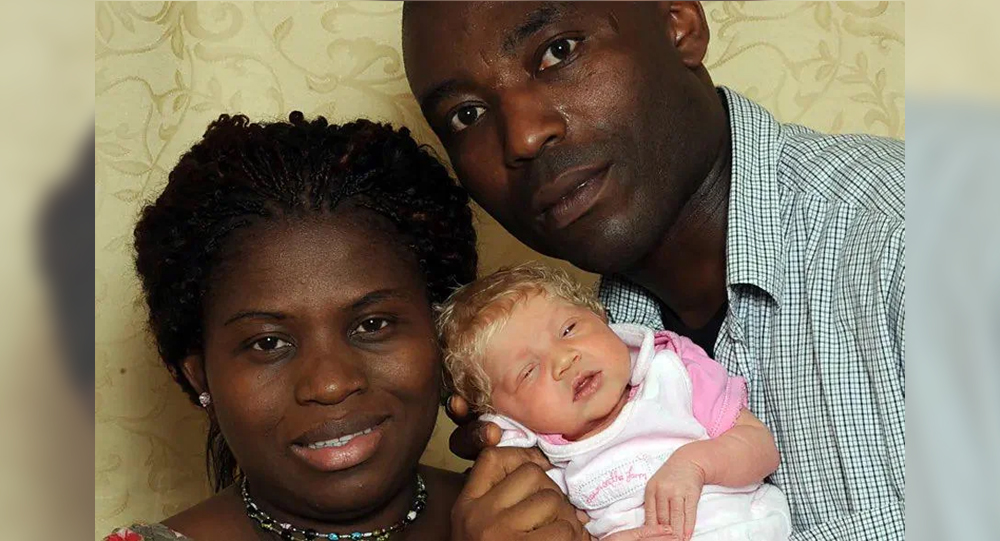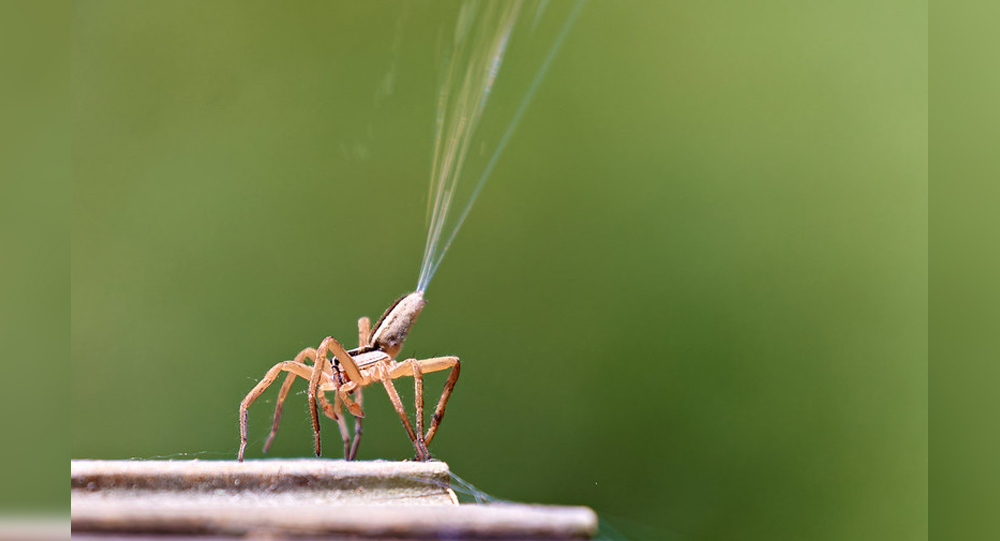
In a remarkable and heartwarming story that has captured the attention of people worldwide, a black Nigerian couple living in the United Kingdom welcomed a baby girl with strikingly unexpected features: blonde hair, blue eyes, and fair skin. Dubbed the “miracle baby” by her family and the media, this infant’s appearance defies common genetic expectations and has sparked curiosity, fascination, and important conversations about genetics, race, and human diversity.
This article delves into the extraordinary story of this family, the science behind such a rare genetic occurrence, and the broader implications for how we understand heredity and identity.
The Story of the Miracle Baby
The Nigerian couple, both with dark skin and African features, were overjoyed when their daughter was born with pale skin, bright blue eyes, and blonde hair. Her appearance was so unexpected that it initially surprised both the parents and healthcare professionals. The baby’s unique features stood in stark contrast to those of her parents and extended family, leading to her affectionate nickname, the “miracle baby.”
The parents have shared their story publicly to celebrate their daughter’s uniqueness and to raise awareness about the complexities of genetics. They emphasize that their daughter is healthy and loved unconditionally, and they hope her story encourages acceptance and understanding of genetic diversity.
How Is This Possible? The Genetics Behind the Miracle
At first glance, a black Nigerian couple having a white, blonde, blue-eyed child might seem impossible. However, the science of genetics reveals that such occurrences, while rare, are entirely plausible.
Recessive Genes and Genetic Variation
Human traits such as hair color, eye color, and skin pigmentation are influenced by multiple genes. Some of these genes are dominant, while others are recessive. Blonde hair and blue eyes are typically recessive traits, meaning that both parents must carry the gene variants for these traits to be expressed in their child.
Even if both parents have dark hair and eyes, they can carry recessive genes for lighter features inherited from distant ancestors. When both parents pass these recessive genes to their child, the child can express these lighter traits.
Genetic Diversity Within African Populations
Africa is the most genetically diverse continent on Earth, with a wide range of genetic variations among its populations. Over millennia, populations have mixed and migrated, resulting in a rich tapestry of genetic traits.
It is possible that the couple’s ancestry includes genetic variants for lighter pigmentation, even if these traits are not visible in the parents themselves. This genetic diversity means that rare combinations can occasionally produce unexpected physical features.
Albinism vs. Natural Variation
While albinism-a genetic condition causing reduced pigmentation-is a known cause of pale skin and light eyes, the couple’s baby does not have albinism. Her pigmentation is natural and healthy, making her case even more unique and fascinating.
Similar Cases Around the World
Though rare, cases of children born with unexpected pigmentation traits to darker-skinned parents have been documented globally:
- In 2017, a South African couple made headlines when they welcomed a blonde-haired, blue-eyed baby, sparking similar discussions about genetics and diversity.
- Other reports from African, Asian, and Latin American countries have documented children with light features born to darker-skinned parents, highlighting the complexity of human genetics.
These cases remind us that human appearance is not always predictable and that genetic diversity can surprise us in beautiful ways.
The Family’s Experience and Public Reaction
The Nigerian couple has embraced their daughter’s unique appearance with pride and joy. They have spoken openly about their happiness and the curiosity their child’s looks have generated.
While some people have expressed surprise or asked questions, the family emphasizes that their daughter is loved unconditionally and that her health and happiness are what matter most. Their openness has helped dispel myths and misconceptions, promoting a message of acceptance and understanding.
The story has resonated with many around the world, inspiring conversations about race, genetics, and identity. It challenges stereotypes and encourages a broader appreciation of human diversity.
The Broader Implications: Rethinking Race and Appearance
This story goes beyond a single family; it challenges common assumptions about race, genetics, and identity. Often, people associate certain physical traits exclusively with specific racial or ethnic groups. However, the “miracle baby” reminds us that:
- Race Is a Social Construct: While race has biological components, it is largely a social and cultural classification. Physical appearance does not always neatly align with racial categories.
- Genetics Are Complex: Human genetics involve many interacting factors, and traits can skip generations or appear unexpectedly.
- Diversity Exists Within Groups: African populations, in particular, have immense genetic diversity, including variations in skin tone, hair texture, and eye color.
- Acceptance Matters: Celebrating genetic uniqueness fosters inclusivity and combats stereotypes.
Fun Facts and Trivia About Human Genetics and Appearance
- Blue Eyes and Genetics: Blue eyes are caused by a mutation in the OCA2 gene, which affects melanin production in the iris. This mutation likely originated thousands of years ago near the Black Sea.
- Origins of Blonde Hair: Blonde hair is most common in Northern Europe but has appeared in various populations worldwide due to genetic mutations.
- Skin Pigmentation: Skin color is influenced by multiple genes that regulate melanin production. Variations in these genes can produce a wide range of skin tones even within families.
- Recessive Genes: People can carry recessive genes for traits they do not visibly express, meaning their children can inherit unexpected features.
- Albinism vs. Natural Variation: Albinism is a genetic condition causing lack of pigment, but natural light pigmentation can occur without any health issues.
What This Story Teaches Us
The birth of a white, blonde, blue-eyed baby to a black Nigerian couple living in the UK is a powerful example of genetic diversity and the wonders of human biology. It challenges preconceived notions about race and appearance, reminding us that genetics can surprise us in beautiful and unexpected ways.
This story encourages us to embrace diversity, question stereotypes, and celebrate the unique traits that make each person special. As science continues to uncover the complexities of our genes, stories like this inspire curiosity, understanding, and a deeper appreciation for the rich tapestry of humanity.
Conclusion
The “miracle baby” born to a Nigerian couple in the UK is more than a rare genetic occurrence; it is a symbol of the complexity and beauty of human diversity. Her story invites us to rethink our assumptions about race and heredity and to celebrate the incredible variations that make each individual unique.
As genetic research advances and our understanding of human biology deepens, stories like this will become more common, reminding us that beneath our skin, we share a common humanity enriched by the extraordinary diversity of our genes.

The “Walking” Palm, tree species can walk up to 65 feet each
This tree species can walk up to 65 feet each year to find the best habitat to live in.

Brazilian Man with Rare ‘Upside Down’ Condition Becomes Successful Accountant and Speaker
Born in Brazil with the rare and debilitating condition congenital arthrogryposis, which caused his head to be positioned upside down, this man was once written off by doctors who urged his mother to let him starve. Defying grim predictions, he overcame immense challenges to become a successful accountant and a powerful international motivational speaker, inspiring millions worldwide.

Why Do Spiders Rain From the Sky? The Strange Ballooning Phenomenon
Every now and then, people around the world are amazed—and sometimes disturbed—to see thousands of tiny spiderlings floating down from the sky, seemingly raining on the earth below. This eerie spectacle is the result of a curious and fascinating behavior called ballooning, in which spiders use silk threads as invisible parachutes to catch the wind and fly. Recent scientific discoveries reveal that spiders can even harness Earth’s electric fields to take off without wind, making their aerial journeys feel almost supernatural. This article explores the science, mystery, and wonder behind the ballooning phenomenon.

The story of a boy who claims to be on Mars: Boriska Kipriyanovich
Boriska Kipriyanovich, who lives in Volgograd, Russia, claims he lived on Mars before being resurrected on Earth on a mission to redeem humanity. What we know about him is as follows:

This Thai Wedding Tradition Happens 40 Feet Underwater
Each year in Trang, Thailand, dozens of couples participate in an underwater wedding ceremony while scuba diving in full gear. The ritual symbolizes deep love and has become a quirky tourist attraction held around Valentine’s Day.

Upside-Down Fig Tree From The Roof Of An Ancient Ruin in Italy
There is an upside-down fig tree in Bacoli, Italy. No one is quite sure how the fig tree ended up there or how it survived, but year after year, it continues to grow downwards and bear figs.

Recipient of suicide victim's heart kills himself 12 years later
In 1995, Sonny Graham received a transplanted heart from a suicide victim. He then committed suicide in the very same manner as the donor.

Khuk Khi Kai: Thailand’s Infamous “Chicken Poop Prison” and Its Gruesome Legacy
Thailand used to have a prison called "Khuk Khi Kai," or "Chicken poop prison." The first floor of the prison contained prisoners, and the second floor was a large chicken coop. The grated floor ensured that prisoners were constantly subjected to chicken poop.

Lucy and Maria The Biracial Twin Sisters with Rare Black and White Skin Colours
Lucy and Maria Aylmer are twins, but they have a hard time to convincing people. Even though they have mixed-raced parents, their mom was still shocked when the midwife handed her babies she’d expected to look alike, but were complete opposite.

The Story of the Hidden Flight Simulator Game in Microsoft Excel 97
Before smartphones ruled hidden gaming, Microsoft slipped an extraordinary secret into one of its flagship office programs: a fully functional flight simulator game inside Excel 97. This little-known Easter egg captivated users who discovered a way to pilot a plane through the grid-like interface. Explore how this unexpected feature was created, the tech magic behind it, and why it remains a legendary piece of software lore.

The Astonishing Case of Sanju Bhagat: Living with a Twin Inside Him for 36 Years
Sanju Bhagat, an Indian farmer, lived with an undiagnosed parasitic twin inside his abdomen for 36 years. In 1999, doctors discovered the twin during surgery. This rare condition, fetus in fetu, occurs when a malformed twin is absorbed during pregnancy, surviving within the host sibling's body.

The Incredible Story of Martin Laurello, The Sideshow Performer With The Revolving Head
Martin Laurello was also known as 'The human owl'. He was born with the ability to turn his head a full 180 degree.

When the Sky Rained Fish: An Unbelievable Encounter Above Alaska
A small Alaskan plane was hit by a fish falling from the sky. It had been dropped by an eagle that misjudged its grip. The plane was unharmed, but it made the news as possibly the weirdest bird strike ever.

The Story of Tsutomu Yamaguchi: The Man Who Survived Both Atomic Bombs
Tsutomu Yamaguchi’s story is one of astonishing survival and resilience. In August 1945, while on a business trip in Hiroshima, he endured the catastrophic atomic bombing and, unbelievably, survived to return to his home city of Nagasaki—only to face a second atomic attack days later. Officially recognized as the only person to survive both bombings, Yamaguchi’s life is a powerful testament to human courage, hope, and the devastating impact of nuclear warfare.

The Google Maps Discovery: the Mystery of William Moldt's Disappearance
In 2019, Google Maps helped solve the decades-old mystery of William Moldt, who disappeared in 1997. A former resident spotted his submerged car in a retention pond while using Google Earth. The vehicle, visible since 2007, contained Moldt's skeletal remains, providing closure to his case.

the world from someone predicting 2000 from a guy in 1910
Villemard, a French artist, illustrated how he imagined the future would be in the year 2000 in 1910.

In 2018, a 30-year-old survived a close-range gunshot thanks to silicone implant
In 2018, a 30-year-old woman from Toronto, Canada survived a close-range gunshot thanks to her silicone breast implant. Doctors believe that the implant deflected the bullet away from her vital organs, and her only injury was a fractured rib.

Japan’s Chicken-Flavored Ice Cream: The Bold Fusion of Sweet Vanilla and Real Grilled Chicken
A Japanese company once created chicken-flavored ice cream using real grilled chicken bits mixed into vanilla. It combined sweet and savory in a way few dared try, but it drew curiosity from foodies seeking extreme culinary experiences.

A woman finds her ex-boyfriend living in her attic 12 years after they broke up
Most people have heard of "things that go bump in the night," but for one South Carolina lady, that "thing" was her ex-boyfriend, whom she discovered living in her attic more than 12 years after they broke up.

The Heartbreaking Story Of Ella Harper, The ‘Camel Girl’
Ella Harper, Professionally known as the “Camel Girl” was born with a rare orthopedic condition that cased her knee to bend backward. Due to this condition, had to walked on all four legs, which resulted in her nickname as “Camel Girl”. Tough it was hard at first, but soon she made a fortune out of it.

What Caused The Mysterious Patomskiy Crater in Siberia?
Discovered in 1949, the Patomskiy Crater resembles a huge convex cone with a funnel-shaped recess and a rounded hill in the middle, which looks like an eagle’s nest with an egg nestled inside it. The crater’s origin is a mystery that has baffled scientists for decades.

Preserving Bodies in a Deep Freeze Await Revival
There are currently hundreds of deceased people in the U.S., including baseball legend Ted Williams, whose bodies are frozen in liquid nitrogen in hopes that future technology will be able to revive them.

The mystery of India's 'lake of skeletons'
In 1942, a British forest guard in India made an alarming discovery. Some 16,000 feet above sea level, at the bottom of a small valley, was a frozen lake absolutely full of skeletons.

A one-eyed Vancouver fish receives a fake eye so that other fish will not bully him
A fish whose eye was removed due to cataract was bullied by other fish at the Vancouver Aquarium. So the vets fitted the fish with a prosthetic eye to fool the other fishes.

Kim Peek: The Real Rain Man Who Memorized 12,000 Books
Kim Peek wasn’t just a man with an extraordinary memory—he was a megasavant whose astonishing ability to recall the contents of over 12,000 books inspired the iconic character Raymond Babbitt in the film Rain Man. Able to read two pages at once, scanning one with each eye, Peek could memorize an entire book in about an hour. Despite his phenomenal talents, he faced developmental challenges and lived a unique life that changed perceptions about human potential and cognitive diversity. This article explores the remarkable story of Kim Peek, his capabilities, and the legacy he left behind.

























